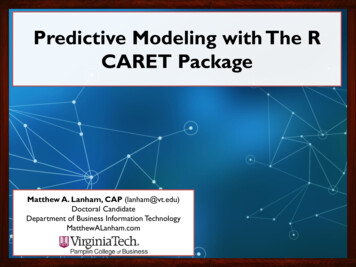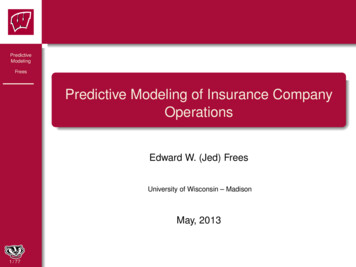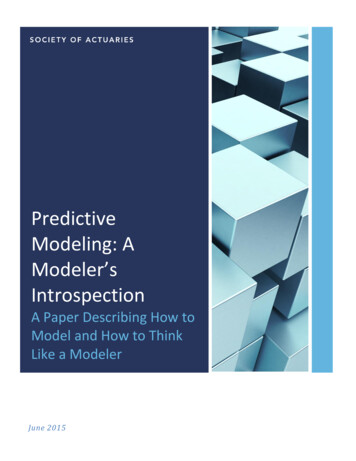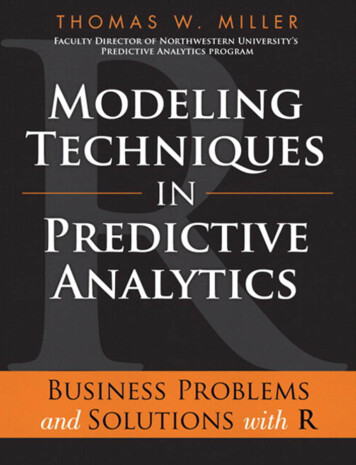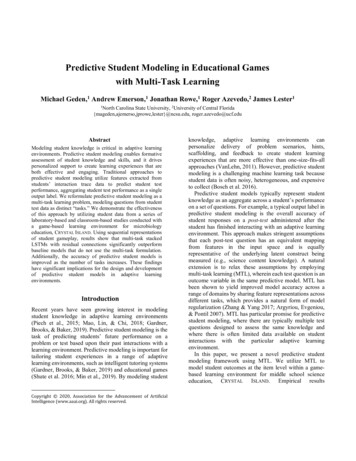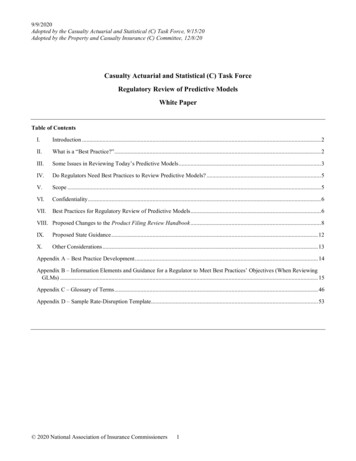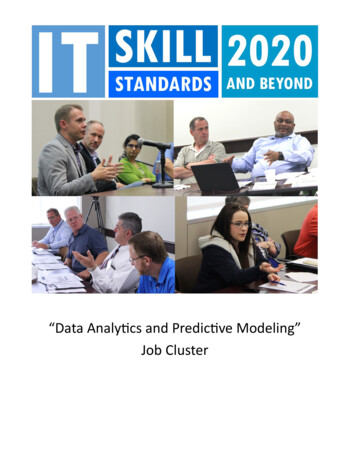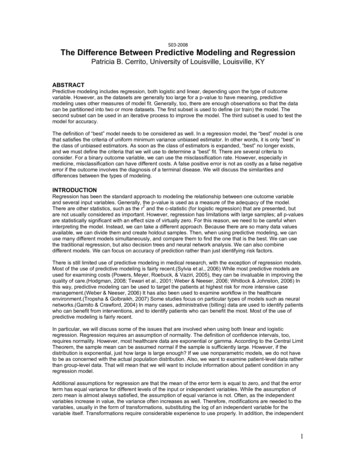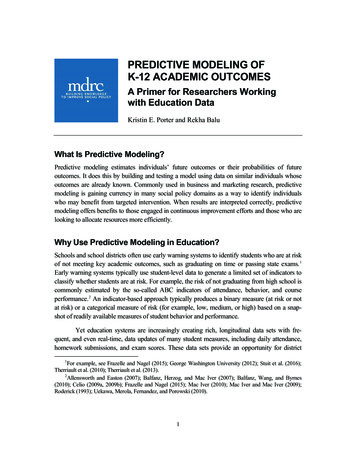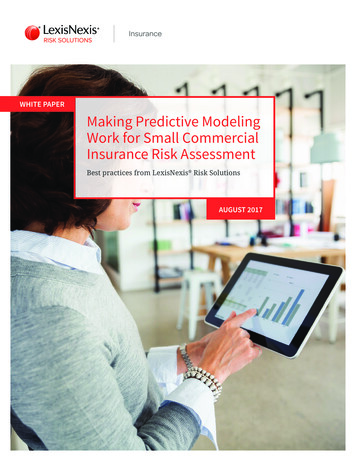
Transcription
WHITE PAPERMaking Predictive ModelingWork for Small CommercialInsurance Risk AssessmentBest practices from LexisNexis Risk SolutionsAUGUST 2017
BEST PRACTICES FROM LEXISNEXIS RISK SOLUTIONSExecutive SummaryWhile predictive modeling has proven itself to be aninvaluable risk assessment tool in personal lines insurance,its adoption in commercial insurance has been relativelyslow, even for small commercial. When an insurance carrierhesitates to integrate predictive modeling into the business,it’s usually because of either a lack of resources or a lack ofunderstanding about how to build an effective model.However, there is another frequent barrier to adoption―concern over organizational engagement in the desire toincorporate predictive modeling into business operations,especially when the ins and outs of predictive modelingremain a mystery to many in the commercial insurance sector.But integrating predictive modeling into small commercialinsurance is easier than many might think. Effectivelyapplying predictive modeling can be likened to the four-stageproduct development lifecycle process of ideation, designand development, implementation, and monitoring.Whether carriers choose to enlist the help of a solutionprovider or build a predictive model themselves from scratch,following a few best practices can make all the difference inachieving a successful outcome when using predictive modelsfor risk assessment.Best Practices from LexisNexis Risk Solutions1
BEST PRACTICES FROM LEXISNEXIS RISK SOLUTIONSApplying Predictive Modeling SuccessfullyWhile predictive modeling has proven to bean invaluable risk assessment tool in personallines, adoption within commercial lines is not aspervasive. Why? Often carriers lack the appropriateresources to build this capacity and/or they do notunderstand where to begin in applying a predictivemodel. W ill our executive leadership understand thebasics of predictive modeling and support itsuse?These limitations are not the only stumblingblocks. Because predictive modeling is still a bit ofan enigma, many organizations are unsure abouthow to introduce and integrate such an initiativeinto their business operations. D o we have enough data to build a predictivemodel?Here is a common scenario. A vice president ofcommercial underwriting learns enough aboutpredictive modeling to believe implementing sucha model is critical to the business’s success, but heor she struggles with questions like these: W ill the potential benefits justify the investmentof company assets and resources? D o we have the necessary expertise to build apredictive model, and if not, what options exist? W hat data sources should be considered for usein the model? H ow long will it take to design and build themodel? W hat will our front line underwriters and, moreimportantly, our agents think? H ow will we know if our predictive modelingproject is a success?There is good newsEffectively applying predictive modeling is astructured process that any organization canfollow. In fact, there are a number of techniquesor best practices that can help carriers make themost of predictive modeling to improve theirbusiness outcomes.Best Practices from LexisNexis Risk Solutions2
BEST PRACTICES FROM LEXISNEXIS RISK SOLUTIONSPredictive Modeling and theProduct Development LifecycleProcessWhen it comes to implementing predictive modeling, carrierstend to find themselves in one of four situations:1. L acking expertise or data to build and incorporate theirown models into the operations workflow.2. C apable of building predictive models, but unable toincorporate them into the operations workflow.3. U nable to build their own models but adept atimplementing vendor or consultant-built models.4. S ophisticated at building and implementing predictivemodels within their operations.Carriers successful at leveraging the benefits of predictivemodeling typically apply a product development lifecycleprocess to their predictive modeling efforts to ensureadoption and use. A product development lifecycle typicallyconsists of the following stages: ideation, design anddevelopment, implementation, and monitoring.A product developmentlifecycle typicallyconsists of the followingstages: ideation, designand development,implementation, andmonitoring.Best Practices from LexisNexis Risk Solutions3
BEST PRACTICES FROM LEXISNEXIS RISK SOLUTIONSIdeationIdeation involves identifying the problem that needs solving and determining whether or notpredictive modeling can help solve it. Before starting the ideation phase, two conditions must be met:1. Establish executive sponsorship2. Establish a cross-functional team for the modeling projectStrong executive sponsorship is critical to success and can help guarantee the right resources andbudget will be applied to the project.A cross-functional team includes membership from all impacted functions (including sales,underwriting, product management, claims, IT, actuary and analytics) and works to engage thebroad support and participation necessary to integrate predictive modeling into the workflow. Teamresponsibilities include: Identifying and validating the business problems to be solved Generating ideas about how to solve these problems with predictive modeling Selecting the best ideas to implement Showcasing the benefits of predictive modeling Pinpointing what costs will be incurred D etermining if the costs of solving a problem with predictive modeling justify the expenditure orwould be better applied elsewhere E xploring how the model will work in conjunction with business operations and what benchmarksand measures will be applied to assess the model’s success Establishing buy-inBest Practices from LexisNexis Risk Solutions4
BEST PRACTICES FROM LEXISNEXIS RISK SOLUTIONSDesign and DevelopmentMany insurance carriers are building a number of different types of predictive models that are used forrisk selection, pricing, claims fraud detection, claims subrogation potential, etc. For small commercial,there is a small, but growing, movement to use predictive modeling for risk assessment and pricing bybuilding an “insurance score” to rank order risks in terms of loss propensity.Design and development of an insurance score takes place across three highly iterative steps:1. Data exploration2. Model creation and validation3. Regulatory reviewDesign and DevelopmentDesign and Development1Data Exploration2Model creation andvalidation3Regulatory ReviewBest Practices from LexisNexis Risk Solutions5
BEST PRACTICES FROM LEXISNEXIS RISK SOLUTIONSData explorationDuring data exploration, different groups work togetherto evaluate which data sources to use and which sourcescorrelate with the target. For small commercial riskassessment, insurance loss is typically the target. The workinggroup responsible for data exploration usually includesbusiness analysts, statistical modelers, IT resources and amember of the regulatory team―which is most often thecarrier’s product manager.There are numerous third-party data sources to considerwhen building a model for small commercial risk assessment.Commercial credit is a very popular data source and issourced from two commercial credit bureaus. For a microbusiness, business owner consumer credit is a commonlyused data source that works well for predicting smallcommercial loss. Public records on either the business owneror business have recently become another popular source forassessing risk. Additionally, many carriers choose to integrateprior loss and/or geospatial data into their predictive models.Best Practices from LexisNexis Risk Solutions6
BEST PRACTICES FROM LEXISNEXIS RISK SOLUTIONSModel creation and validationWhen building a predictive model, carriers need a largesample of data to train their model to predict the target andto test and validate that it works. The data must include thevariable, “the target”, that is being predicted. This sample datawill be partitioned into two distinct sets:1. Training data2. Testing dataTraining data – The training data is used to identify whichvariables correlate with the target being predicted and whatweightings should be applied to those variables withinthe predictive model. While many variables may correlatewith the target, steps should be taken to mitigate the useof these variables that correlate with each other―calledmulticollinearity. Predictor variables that correlate with eachother can create unstable model weights, thus making itdifficult to assess the effect of the variables on the target.Testing data – The data for testing is used to simulateproduction and validate the model predicts the target orwhether further refinement is necessary.When building a model to assess small commercial risk,carriers typically use a large sample of both commercial policypremium and claims data. When organizations do not havesufficient data to build their own model, they will need toleverage a model developed by a vendor or consulting group.The data mustinclude thevariable, “thetarget”, that isbeing predicted.Best Practices from LexisNexis Risk Solutions7
BEST PRACTICES FROM LEXISNEXIS RISK SOLUTIONSTo assess a score’s efficacy for small commercial risk assessment, LexisNexis uses historical policy andloss data, scores the policies with data from the past, and leverages a gains chart to assess how wellthe score performs. The gains chart measures loss ratio against score deciles. As the score improves,the loss ratio should decrease―if the scoring system is working correctly.We look for the following characteristics when assessing a score’s benefit: Lift—What is the ratio between the best-performing group and the worst-performing group? S mooth segmentation—Is there a smooth trend as the score moves from the worst-performing groupto the best-performing group? As the score improves, does the loss ratio associated with that groupdecrease?Properly segmented insurance scores allow a carrier to establish groups in order to automateunderwriting to decline, refer or accept business without underwriter intervention. These types ofsegmenting scores are also easily incorporated into rating or tiering algorithms.Small Commercial Underwriting Requires Actionable ScoresInsurance ScoresChart 1: Incurred Loss RatioDeclineIncurred Loss Ratio100%% Total Loss90%80%80%70%70%PercentageRefer% Total %25%14%10%1Worst12% %10212% %11313%10%11%4512%8% 10%6Score Group12%11%7%7% 88%8% 995%8%10BestThe lift chart above demonstrates a score’s efficacy in predicting loss ratio, as the score improves the loss ratio which isrepresented by the red bar decreases. In addition to the smooth segmentation, the score also demonstrates lift in the ratiobetween the best performing decile, decile 10, and the worst performing decile, decile 1.Best Practices from LexisNexis Risk Solutions8
BEST PRACTICES FROM LEXISNEXIS RISK SOLUTIONSRegulatory reviewCarriers and solution suppliers must also consider the impact of the regulatory landscape on thedata sources and attributes used in the models they create for small commercial risk assessment andpricing. When applying a predictive model for commercial insurance underwriting and pricing, moststates require the model to be filed. Not all states will be in agreement about which data sources andattributes are permissible. Ideally, the same model will be used across all applicable states, but oftenstate exception logic will be necessary to comply with state requirements.Implementation ConsiderationsThere are several key steps that allow for a successful implementation. While a number oforganizations are extremely successful in developing a model that predicts their target, many othersstruggle when it comes to fully integrating the model into their operations and workflow. There areimpacts to many parts of the organization and many decisions to be made. Discretionary pricing Rating Underwriting company te Process Review Document changes Building/Testing Application workflow Storage and tracking Required Not Required Internal ExternalBest Practices from LexisNexis Risk Solutions9
BEST PRACTICES FROM LEXISNEXIS RISK SOLUTIONSImplementation Considerations – For smallcommercial risk assessment, carriers mustdecide how to incorporate the score into theirpricing and underwriting. Will they use the scoreonly to justify discretionary pricing or will theyincorporate it into their rating or writing companyselection? They must also identify and documenthow, if at all, underwriting rules and procedureswill change.IT Systems Integration – Once the rating andunderwriting changes are determined, theimplementation team will need to work closelywith the IT team to build the production versionof the score, incorporate the score into theapplication workflow, and store and track scoreusage. IT may have additional concerns over howmuch programming and testing will be requiredto integrate the score within the workflow andhow the implementation will be rolled out toproduction.Dispute process – Depending upon the datasources used in the model, it’s also importantto ensure a dispute process from the applicantor insured can be supported. To assess smallcommercial risk, many carriers use “consumerreports” (as defined by the Fair Credit ReportingAct “FCRA”) such as a consumer credit report.When using a data source subject to the FCRA,insurance carriers need to be prepared to provideadverse action notice when coverage is denied orpriced in a more expensive rating tier.Stakeholder training – All impacted parties, bothinternal and external, will need to be trained onthe model and how it will be used, its benefits,and how success will be measured. Sales andMarketing must develop a communicationplan to explain the score to their marketingrepresentatives and agents. Lastly, organizationsmust decide how they will roll the score out acrosstheir operations. Will use of the score be phasedor rolled out to production all at once?For small commercialrisk assessment, carriersmust decide how toincorporate the scoreinto their pricing andunderwriting.Best Practices from LexisNexis Risk Solutions10
BEST PRACTICES FROM LEXISNEXIS RISK SOLUTIONSMonitoringA model is only as good as its results. Tracking ongoing performance and making necessary changesare a vital part of ensuring a model works for the business. There are two basic components inmonitoring for predictive modeling:1. Tracking usage2. Monitoring efficacyTracking usage – Scores should be tracked both when they are used and when they are overridden.When they are overridden, it is essential to know who overrode the score and why. Allowing for anddocumenting score overrides provides valuable insight into score limitations and how the score and itsimplementation should be improved in the future.Monitoring efficacy – Carriers must also periodically monitor the overall efficacy of the model. Is itachieving the desired results? Do performance indicators meet expectations? If not, a deep dive intothe underlying causes is required. Models may need to be recalibrated or rebuilt. Recalibration viewsthe model as essentially working, but requires adjustments to individual variables to achieve thedesired results. Rebuilding is creating a totally new model and revisiting all of the product phasesfrom Ideation to Design and Development, and subsequent phases, to revisit past assumptions andconsider new and/or additional data sources.Management—Supportand Maintenance1Tracking UsageAllowing overrides, but documentthe reasons whyManage2Monitor EfficacyBest Practices from LexisNexis Risk Solutions11
ConclusionA well thought-out, deliberate plan that aligns with a product development lifecycle process is the keyto a successful predictive modeling implementation—enabling commercial insurers to realize the fullbenefits of predictive modeling for small commercial risk assessment and pricing. Critical elements inthis effort are executive sponsorship, a competent and engaged cross-functional project team, and afour stage life-cycle process of ideation, design and development, implementation, and monitoring tosteer the process.In our experience, carriers who’ve applied these best practices have truly transformed their businesses.We hope you will find these guidelines useful, and be able to leverage them in ways that help yourbusiness grow and prosper.Mathew StordyDirector, Commercial InsuranceMathew Stordy is Director of Commercial Insurance for LexisNexis Risk Solutions. Stordy isresponsible for requirements assessments and the design of data solutions and services thatstreamline commercial insurance processes and provide insights about entities through the useof data, analytics and software. Prior to joining LexisNexis, Stordy worked extensively with policyadministration systems, quoting applications and business intelligence solutions. He holds abachelor’s degree in mathematics with a minor in computer science and a master’s degree inphilosophy from the University of Connecticut.For more information, call 800.458.9197, or emailinsurance.sales@lexisnexisrisk.comAbout LexisNexis Risk SolutionsAt LexisNexis Risk Solutions, we believe in the power of data and advanced analytics for better risk management. With over 40 years of expertise,we are the trusted data analytics provider for organizations seeking actionable insights to manage risks and improve results while upholding thehighest standards for security and privacy. Headquartered in metro Atlanta, USA, LexisNexis Risk Solutions serves customers in more than 100countries and is part of RELX Group plc, a global provider of information and analytics for professional and business customers across industries.For more information, please visit www.risk.lexisnexis.com.LexisNexis and the Knowledge Burst logo are registered trademarks of RELX Inc. Other products and services may be trademarks or registered trademarks of theirrespective companies. Copyright 2017 LexisNexis. NXR12001-00-0817-EN-US
incorporate predictive modeling into business operations, especially when the ins and outs of predictive modeling remain a mystery to many in the commercial insurance sector. But integrating predictive modeling into small commercial insurance is easier than many might think. Effectively applying pred
